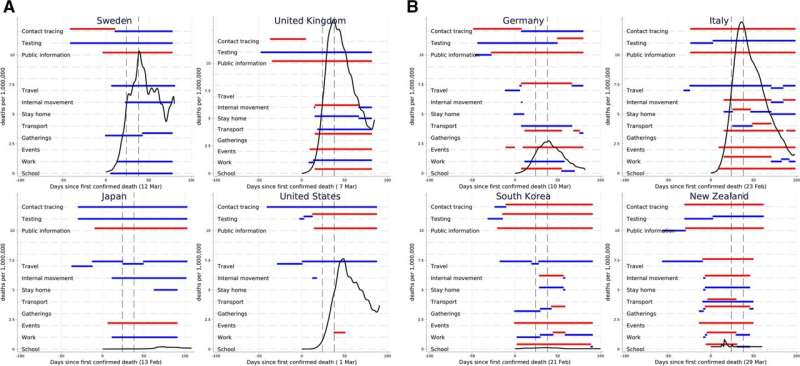Closing schools and workplaces linked to reduced early COVID deaths

Closing schools and workplaces appear to have been the most effective strategies to mitigate deaths from COVID-19 in the early days of the pandemic's first wave, according to a study of 130 countries.
The team from The University of Manchester and Imperial College London analyzed the relative effects of different non-pharmacological interventions aimed at controlling the spread of COVID-19. The study is published in BMC Public Health.
Of the nine interventions they examined, only closing schools and closing workplaces had a significant association with a decline in early COVID-19 attributed death rate.
Closing schools reduced mortality by 1.23 daily death per million over 24 days and closing workplaces reduced mortality by 0.26 daily death per million over 24 days.
For the U.K., with a population of about 67 million, this would translate to roughly 82 and 17 daily COVID-19 deaths, respectively.
The main analysis used a mean score of strictness and timeliness for each intervention, to incorporate the full exposure of each country to each intervention.
However, examining strictness of interventions alone, stricter international travel controls, and timing of interventions alone, later restrictions on gatherings (when tighter restrictions were implemented), were also associated with lower COVID-19 mortality but only marginally.
Other interventions, such as stay-at-home orders ("lockdowns") or restrictions on public transport, were not significantly associated with differences in mortality rates across countries in the period of analysis after controlling for other interventions.
The team used sophisticated statistical modeling to generate 3,250 observations describing the association of an intervention with daily deaths per million over the next 24-days, the average estimated time between virus transmission and death.
To reduce study bias, they compared interventions implemented in the period before the first COVID-19 death, when policymakers wouldn't have been able to react to deaths that had already occurred, and 14-days-after the first COVID-19 death, when numbers were still low and bias could still be minimized.
Lead author Dr. Jonathan Stokes said: "There have been many policies enacted by Governments around the world to control COVID-19 transmission.
"Many of them can have some impact on reducing virus transmission, though they can also hurt our mental health and the economy.
"However, their relative impact on COVID-19 mortality is less clear, and that makes it harder for policy makers to create the maximum benefit with the minimal disruption.
"The way these interventions were rolled out, non-randomly and frequently multiple interventions in tandem, makes it extremely difficult for any single study to give a definitive answer on effectiveness of each."
He added: "However, our study contributes to the growing literature and our clear finding was that schools and workplaces were linked to lower mortality in the early period of the pandemic. We're not saying schools and workplaces should close but rather, policy makers might build these insights into their subsequent pandemic strategies in the future.
"With COVID-19, the school environment itself was lower risk due to the age profile of mortality effects, but might present a higher risk in terms of driving up community transmission of COVID.
"Schools and workplaces also represent places where compulsory social interactions occur, rather than voluntary ones such as going to a restaurant or pub, which a high-risk individual (for example, an older person, or person with existing medical conditions) might choose to avoid.
"Other research has also suggested this large voluntary mechanism, where community mobility rates have been shown to have fallen before interventions, such as stay-at-home orders, were even implemented, and mobility fell in comparable amounts in U.S. counties without stay-at-home measures compared to those with.
"So perhaps focusing on interventions to reduce social interactions in 'compulsory,' not 'voluntary,' settings appears to have been the most effective strategy to mitigate early COVID-19 mortality."
The study was based on data from early on in the pandemic, necessary to mitigate bias in the results, so it is not possible to speculate what these relative effects might have been in the second or subsequent waves. Behavioral responses might not have been the same as they were to the initial shock of the pandemic.
More information: Jonathan Stokes et al, The relative effects of non-pharmaceutical interventions on wave one Covid-19 mortality: natural experiment in 130 countries, BMC Public Health (2022). DOI: 10.1186/s12889-022-13546-6




















